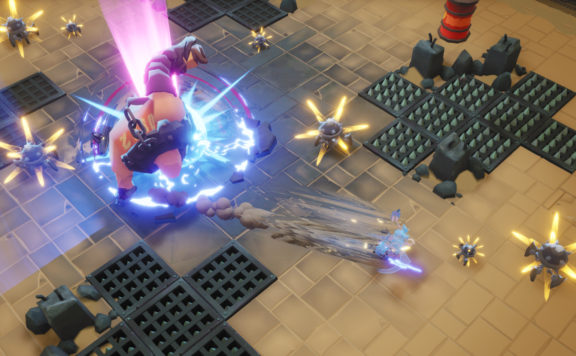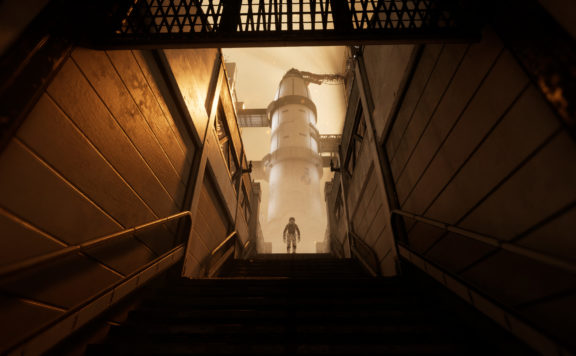While walking around the floor at PAX South this weekend, I came across Phantom Doctrine. A CreativeForge Games title, the game is heavily cloaked in the shadows of espionage. As a former Army Intel guy, it’s a premise that got my attention, even as the cold-war bunker theme of the booth caught my eye.
Built using the Unreal Engine, fans of the XCOM series will immediately see echoes of that extraterrestrial cousin in this new gritty cold war spy-thriller. Phantom Doctrine also offers a lot for history-buffs and folks who just enjoy a little suspense-filled intrigue as the setting pulls from actual events to form a tension-filled backdrop for the deeper storyline.
It’s a game that I expect I’ll enjoy a lot, but others maybe not so much. Let’s take a look at key points that help define what Phantom Doctrine is or isn’t, and hopefully you’ll have a better idea about whether you should be excited about this game. There are definitely some commonalities with XCOM2, but there are some departures from that design, too. Also, there’s a backdrop for the game that adds a historical context that many may find appealing, even some who aren’t normally interested in games may find Phantom Doctrine approachable.
The Interface You Know
There’s a lot about Phantom Doctrine that calls XCOM2 to mind. The interface at first glance and the basic movements of the game are very similar. The basic tactical movement in the game is turn-based and uses a cover mechanic that looked to my eye very much like what I’d found in XCOM2, and plenty of other turn-based and real-time games using that same 0%, 50%, 75%, 100% cover system.
I also saw what looked like similar environmental effects, such as the blue-scaled colors for the night map the developer walked me through as part of the demo. In theme, the art style seemed like an 80’s version of assets that probably wouldn’t be out of place in XCOM2. And of course, the UI being made on the same tech echoes deeply between the games, though I’d note that I didn’t have much chance to really play it myself and can’t say how deeply that similarity goes. I suspect the mechanics of the game will create some significant divergence in the UI.
The color pallet, sounds, and feel of the game all deliver on that same surreal feeling that I got from XCOM. I really liked that aspect of it in particular and felt it fit Phantom Doctrine well. The player is running an organization that’s trying to put together the pieces of a globe-spanning conspiracy. Both games share a sense of being the underdog, being massively out-gunned, and that foreboding and tension that comes with trying not to be discovered and crushed while putting pieces of a puzzle together.

The interface is very similar to other games in the turn-based tactical genre.
The Systems You Don’t
While there’s plenty of similarity between Phantom Doctrine and XCOM2, certainly enough to express some general ideas of what the game is like, there are some pretty key differences, too. Besides the obvious differences weapons, Phantom Doctrine being set in the 1980’s and having period equipment, mechanics like research, recruitment, base-building, and all the rest is a lot different.
Phantom Doctrine doesn’t have a single base, but rather the player has a base of operations that is moved to new cities when enemy agents get close. It’s a cool mechanic that has Cabal agents being sent to various cities around the world to scout out enemy bases of operation, lay down false leads on the location of friendly assets, and scout out potential safe houses for the periodic relocation of friendly activity.

Send agents around the world to collect intelligence or interfere with enemy operations, just remember not to leave the base totally undefended.
Another difference is that is that there are no technicians or scientists, but rather agents do it all. That means the player is constantly forced to choose what’s more important. Is it better to interrupt enemy agents attempting to discover your base of operations in a new city, or to interrogate the enemy agent you recently captured in the city you just came from? Two other agent-specific differences are that agents can be drugged during interrogation (a la MKULTRA for those in the know) or before a mission to increase performance. Also, Phantom Doctrine has a system of support roles for tactical missions. Besides the agents you control in the mission, agents can be assigned to off-map roles like sniper (to take out that guard on the second floor) or providing over watch to give the player intel about an unobserved portion of the mission area.
A cool throw-back to pre-digital intelligence is the investigation board. As agents complete missions and gather intelligence, data is added to a cork board. The player then shuffles through the collected data, drawing string between connected pieces of information. Once the mystery is solved, a related mission is generated, and the player deploys the team.
The Events We Lived
Set in 1983 with the backdrop of a cold war between the US and Russia in full swing, Phantom Doctrine takes a subtle turn from history by couching many of that era’s headline news in a more sinister light by suggesting the hand of a secret organization. This shadow puppeteer, called “the Conspiracy,” is manipulating both sides of the cold war in an effort to create a state of global chaos where no nation trusts any other.

Monochrome radar displays and gritty metal desks were iconic features of the era.
Standing between this amorphous security and a more rational and cooperative world is the “Cabal.” The player acts as a member of the Cabal, a loose group of intelligence operatives from various nationalities and organizations who have detected the subtle hand of conspiracy. Pooling together and working to recruit more to their ranks, the Cabal is working to learn more about the Conspiracy and prevent the chaos their conspiratorial plots are attempting to achieve.
I think those with some background in intelligence operations and anyone with a strong grasp of geopolitical history will find a great deal of entertainment, and perhaps something value, in exploring the older days and methodologies of espionage. A number of major headlines from the 80’s can be found in the game, from the shooting down of a Korean Airliner by Russian MiGs, to a US invasion of Granada. It’s all captured and used by the game to create this sense of realism and suspense, but subtly twisted as the player learns more about the forces in play maneuvering nations in to these situations.
What I Thought
Plainly, I loved what I saw of the game. There’s yet a lot to learn before any determination could be made of whether Phantom Doctrine is a buy or not, though. While I find the setting really interesting and the developers’ descriptions of what they’re doing with the storyline fascinating, there’s still the question of how well they execute on their plans.
The setting and story of Phantom Doctrine are going to be critical to making this game a success, I think. It happens to be the one main unknown about the game. That said, there are good indicators for success.

Agent Theremin tends to whine a lot and gets on everyone’s nerves. I know how to make her stop…
Some of the things I’ve already seen, I really liked a lot and found to be in really good shape for a game that’s probably just now hitting the polish stage of development. The way the game uses agents, the system of recruiting new agents or turning enemy ones, and the vintage concepts on altering agents through hypnosis and drugs all provide fertile ground for cool storytelling.
I also found the idea of bases really being just temporary safe houses that get evacuated the moment they’re burned was a cool idea. Plus, the intelligence and counter-intelligence play of protecting current bases, setting up new ones, and conducting counter-espionage operations in other cities brings cool game mechanics that also directly contribute to the atmosphere of Phantom Doctrine.
Phantom Doctrine is a game that I suspect will do well on release, and I’m excited to see it hit market. There are a few games out there featuring the Cold War period, but I can’t say that I can think of any too similar to this one. In the end, I love seeing studios taking shots at new ideas. It’s what makes going to events like PAX South fun.
All stations, traffic complete. Red Actual out.








